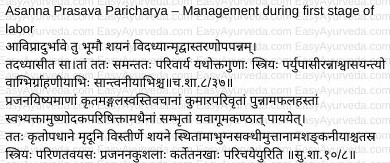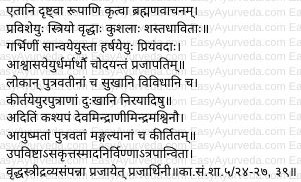Management Of Labor In Ayurveda – Prasava Paricharya
By Dr Raghuram Y.S. MD (Ay) & Dr Manasa, B.A.M.S
Management of labor in Ayurveda is explained in four steps.
1. Management during first stage of labour – Asanna Prasava Paricharya
2. Management of ‘failure in descent of fetus’ -Anagata Prasava Paricharya
3. Instructions for bearing down efforts – Pravahana
4. Management after descent of fetus – Avak Garbhasya Paricharya

Table of Contents
1. first stage of labor
Management during first stage of labor – Asanna Prasava Paricharya
Provision of comfortable seating – After the onset of laboor pains, the pregnant woman should be made to sit comfortably on a soft cushion spread over the ground.
Company of experienced and compassionate women – Many multiparous women who are good hearted and affectionate in nature, who are service minded and indulged in selfless service continuously, possessing strong character, having good endurance and capable of keeping the parturient woman happy and experienced in conducting the labour should stay around the pregnant women. They should encourage the pregnant women by pleasant and consoling words.
Recitation of hymns – When the woman is ready to deliver the child, Brahmans should recite auspicious hymns for the welfare and prosperity of the woman and child. Kautuka Mangala hymns shall be recited.
Presence of male children – The pregnant woman should be encircled by kumaras – male children. The children should hold the fruits bearing the masculine names in their hands.
Abhyanga and Yavagu – She should be massaged with herbal oils followed by bath with lukewarm water. Later she should be given strengthening gruels to drink to her fullest capacity.
Additional – Massage should be given with lukewarm oil over flanks, back, sacrum and thighs. This procedure will help in bringing the fetus down.
Read – 15 Precautions And Benefits Of Massage In Pregnancy
Positioning the woman and preparing her for delivery – The pregnant woman should be made to sleep in supine position (on her back facing the ceiling) on a soft bed having pillow. She should keep her thighs flexed. She should be attended by four expert women having their nails trimmed, who are mature and undaunted.
Also – Woman shall be made to sleep on bedding made up of soft cushion spread over the ground and covered with skin of red bull. The attending women should have worn intact clothes, should be those whose efficiency shall not be doubted, good looking, aged, expert in conducting labor and have their nails trimmed.
Dhuma / inhalation of medicated smoke – Repeated inhalation of one or more of the below mentioned herbs shall be given to the pregnant woman
a. Kushtadi churna
- Kushta – Saussurea lappa
- Cardamom
- Langali – Gloriosa superb
- Vacha – Acorus calamus
- Chavya – Piper retrofractum
- Chitraka – Plumbago zeylanica
- Chirabilva – Holoptelea integrifolia
b. Intermittent inhalation of the smoke of the below mentioned herbs shall be given –
- Bhurjapatra – Betula utilis
- Leaves of Shimshapa – Dalbergia sissoo
- Sarjarasa – Resin of Vateria indica
According to Master Indu, these inhalations shall be given during the periods in between the contractions.
Explanation by Master Kashyapa (Ka.Shaa.5/24-27, 39)
Duties of attending women
- When signs of onset of labor are seen in the pregnant woman, senior experienced women should enter the labor ward after having taken bath. Before this, the Brahmanas should have recited words for welfare.
- These women should urge Prajapati for economic and religious achievements
- They should console, encourage and delight the pregnant woman with good and encouraging words
- They should narrate about the pleasures of having children in one’s life and also about the sorrows of childless couple to the woman in labor
- They should offer prayers to Aditi, Kashyapa, Deva, Indrani, Indra, Ashwini kumaras and auspicious Gods
Read – After Delivery Care Of Mother For First Three Months By Ayurveda
The pregnant woman who is about to deliver should –
- Keep happy
- Be free from shyness
- Sit comfortably while she is surrounded with old women and money
- Should make attempts for delivery
- Use meat soup
Other important points in management of first stage of labor
Massage shall be given below the navel region. She should be encouraged to yawn repeatedly and do slow walking. According to Arunadatta massage with oil avoids aggravation of vata. It shall be used until expulsion of fetus.
Massage should be given around the vaginal canal5.
References
- Cha Sha 8/37
- Su Sha 10/8
- AS Sha 3/18-20
- A.Hr.Sha.3/18-20
- Bha.Pra.Pu. 3/344-347
Read – Ayurvedic Post Natal Care – The First Week After Delivery
2. Failure in descent of fetus
Anagata Prasava Paricharya – Management of ‘failure in descent of fetus:
Sometimes in spite of having labor pains it may not be possible for the pregnant woman to deliver the child.
In this case, the woman should be advised to do one or the other of the below mentioned activities so as to facilitate the process of delivery1.
- To use pestle and mortar – Paddy should be filled in the mortar. The pregnant woman who is unable to deliver the child should be asked to get up and strike the paddy filled in the mortar using a pestle or any other heavy thing.
- Yawn – The woman should be encouraged to yawn repeatedly.
- Walk – She should walk in between yawning.
- Inhalation of herbal fumes – should be done with Kushtadi or Bhurjapatradi herbs already mentioned in the management of first stage of labor.
- Massage – with gentle kneading should be done with lukewarm oil over the waist, flanks, back and thighs.
All the above mentioned measures will help in the fetus descending downwards.
Note – Master Atreya contradicts heavy exercises including using pestle and mortar during delivery. During this time, all doshas and tissues are either excited or moving all through the body. The vata aggravated due to heavy exercise in delicate women enters the hollow spaces of the body and kills the pregnant woman.
Read – Monthly Development Of Fetus – Ayurvedic perspective
Explanation by Master Kashyapa
Master Kashyapa too contradicts heavy exercise during pregnancy and during labor. During labor time the body of the pregnant woman is delicate, all doshas are aggravated and all tissues are displaced. The condition of the pregnant woman is very delicate during this period and her body will have predominance of kleda i.e. humidity. The woman would be more depressed and filled with fear of complications. The woman is thus more vulnerable for diseases and sorrow.
Other woman on observing her agony remark that one foot of the pregnant woman is in the house of God of Death and the other on this side. This means to tell that the woman can die at anytime soon. Any exercise can kill the pregnant woman immediately. Even excessive walking can kill the fetus and produce several fatal disorders.
Just like Master Charaka, Kashyapa too has mentioned inhalation of medicinal fumes and oil massage to be done. While giving massage the women should try to bring the fetus downwards. He has also advised the use of gruel to quench the thirst.
Other opinions
Fetus having gone to the opposite or wrong direction should be brought to the right direction. The fetus which is (in its position and) straight should be pulled or extracted2.
1 aksha quantity of boiled red rice mixed with sour drinks and cow’s urine should be served. Alternatively the rice should be given with decoction of Danti – Baliospermum montanum, Dravanti – Croton tiglium, Vrscikali – Tragia involucrata, Punarnava – Boerhavia diffusa and Banatiktaka – . Similarly the gruel prepared with old rice also shall be given. If the fetus doesn’t descent with all these measures, oil enema – anuvasana vasti should be given with tikshna taila – pungent oil3.
References
- Cha Sha 8/38
- Su Sha 10/10
- Bhe.Sam.Sha.8/8
Read – Embryology As Per Ayurveda
3. Bearing down
Pravahana – Instructions for bearing down efforts
The role of female attendants in bringing about easy delivery of the child in the ward is very important.
Bearing down efforts are important on the part of the woman in labor. If she does that the child will be pushed down and the delivery becomes easy. But she should be wary of not doing that when the pains are absent. This instruction should be given by attendant women. 1They should tell the pregnant woman not to bear down in the absence of labor pains because it is not going to help her in the progress of labor. When the woman bears down in the absence of labor pains, her child would become abnormal, deformed or afflicted with dyspnea, cough, emaciation and spleen disorders. Bearing down efforts made in the absence of labor pains do not bring the fetus down. Similarly absence of efforts to bear down when labor pains are present is also harmful. To avoid any complications the woman should bear down as instructed by senior women.
The bearing down efforts shall be mild to begin with, early in the second stage of labor. Towards the end of labor, the bearing down efforts shall be forceful. When the woman in labor is bearing down, the attendants should pronounce ‘delivered, almost delivered, you are fortunate, yes, you are fortunate…you have delivered a male child’. Hearing these encouraging words the woman would get strength to involve herself more in the process with happiness.
Read – Diet And Lifestyle For Women In Ayurveda
Range of bearing down efforts
- Gentle efforts – When the fetus has descended slightly and when the pain is felt in the region of pelvis, groin and neck of the urinary bladder, the bearing down efforts shall be gentle.
- Strong efforts – When the fetus descends further down, the bearing down efforts should be strong.
- Strongest efforts – When the vertex of the fetus has appeared at the vaginal orifice, the bearing down efforts should be the strongest and should be done till the fetus has been delivered.
Master Dalhana opines that the bearing down efforts should be continued until the placenta is expelled.
Complications occurring due to bearing down efforts being made in the absence of labor pains –
- Deafness
- Dumbness
- Dislocation of mandible
- Diseases of head and neck
- Cough
- Dyspnoea
- Emaciation
- Abnormal location of body parts of the child
References
- Cha Sha 8/40
- Su Sha 10/9
4. After descent of fetus
Avak Garbhasya Paricharya – Management after descent of fetus
Advice to bear down the child and chanting the hymn1 – The woman should be made to lie down on the bed when the fetus has descended downwards. She should also be advised to bear down.
- Another woman who is compassionate with the pregnant woman should constantly chant a mantra in feeble voice – ‘Hey woman, May the five elements of nature, Vishnu and Prajapati protect you who is carrying the fetus in your womb. May they free you from this Shalya – the fetus acting as a foreign body in you! Oh beautiful woman, you deliver the child without any difficulty, the child who is free from all troubles and tiredness. May the child be protected by Kartikeya and resemble him in every aspect!’
- ‘O beautiful lady, bear down slowly, your facial expression is charming, you will surely deliver a male child’. The other woman should recite the same verse as explained above (a). And also should add up saying ‘Similarly amrtam, soma, chitrabanu, bhamini and ucchaihsrava should live in your house and protect you. O woman, this nectar obtained by churning the sea should expel your small fetus. Agni, Vayu, Surya, Indra and Samudra should provide you comfort and solace’2.
Massage3 – Massage should be done gently on the genitalia in the direction of the hairs. The attendant should do this by sitting at the foot end of the delivering woman and also compress the hips with her foot and repeatedly dilate the vaginal canal2.
References
- Charaka Samhita Shareera Sthana 8/39
- Ashtanga Sangraha Shareera Sthana 3/24-29
- Sushruta Samhita Shareera Sthana 10/9
With the above said measures the delivery of the child takes place in a normal way in normal time without much difficulty.
Sanskrit Verses


Management of other aspects of labor
Garbha Sangha Chikitsa – Sometimes there is delay in labor and it has to be efficiently managed. This shall be treated with the help of external or internal treatment or usage of mantras or mixture of all.
Apara Patana – Expulsion of placenta is an essential part of normal labor. If the placenta is not expelled all by its own the placenta needs to be removed. Many measures of doing this includes external manipulation, fumigation of vagina, anointment and filling in vagina with medicinal herbs, irrigation, tampons, oral medications and medicinal enemas.
Akala Prasava – means untimely labor. This can either be premature labor or delayed labor.
Mrta Garbha and Mudha Garbha – Mrta Garbha means intrauterine death of fetus. Mudha Garbha means obstructed labor. These two conditions need to be dealt with in proper time with proper interventions failing which may lead to serious complications.
Click to Consult Dr Raghuram Y.S. MD (Ayu)









